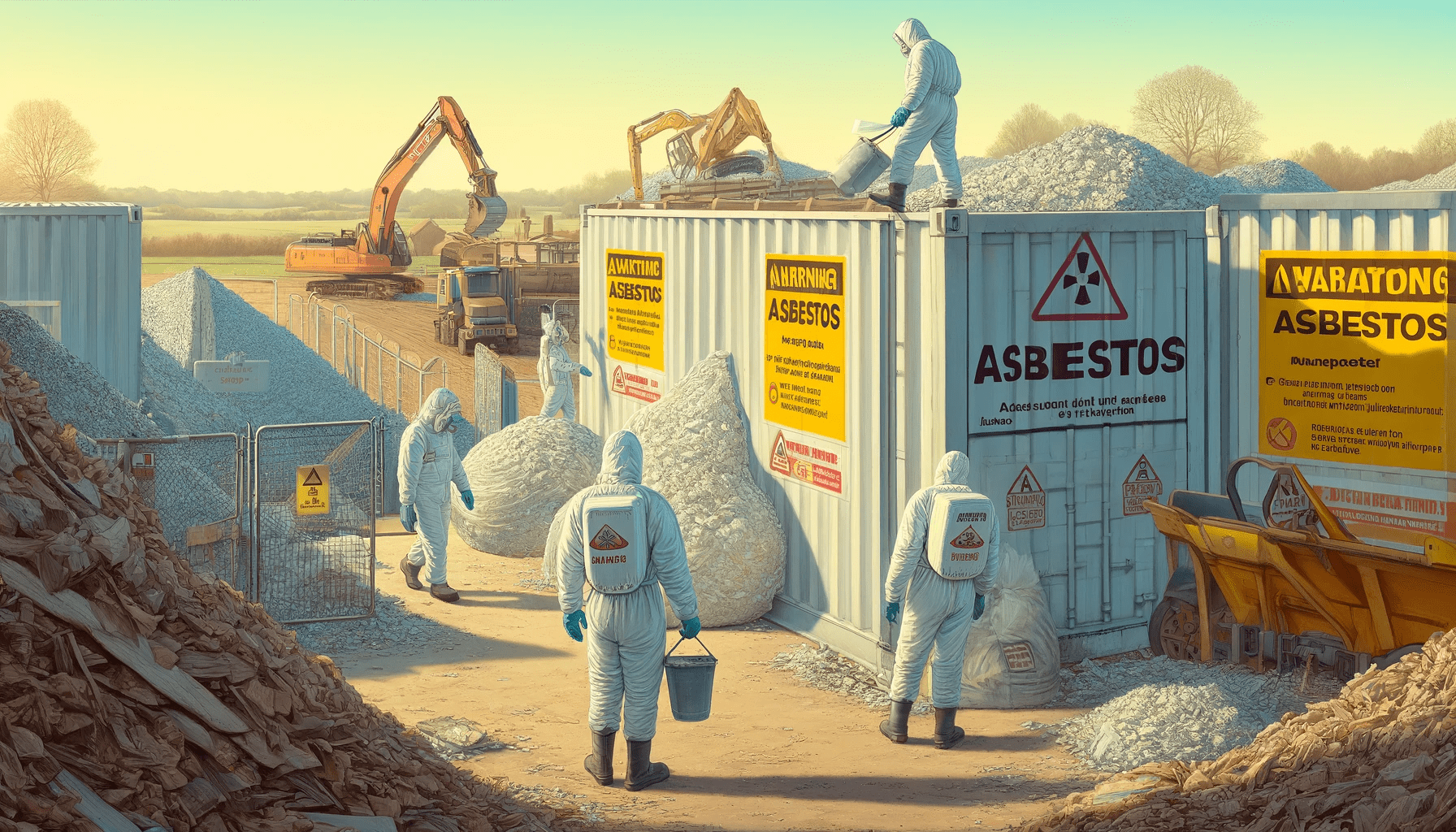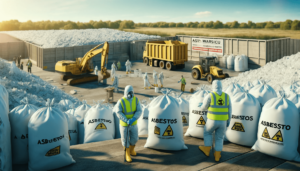
Asbestos Disposal Methods
Asbestos Disposal: Ensuring Safety and Environmental Integrity
Understanding and correctly implementing asbestos disposal methods is crucial for safeguarding public health and the environment. Once a widely used material for its durability and heat-resistant properties, asbestos is now known for its health risks, making its safe disposal a subject of utmost importance.


Introduction to Asbestos and Its Hazards
The Legacy of Asbestos in Construction
Asbestos, a group of naturally occurring fibrous minerals, was extensively used in building materials for its fire resistance, insulation, and strength. However, the revelation of its harmful health implications led to a decline in its use and strict regulations on its management.
Health Risks of Asbestos Exposure
The inhalation of asbestos fibres can lead to severe lung diseases, including asbestosis, lung cancer, and mesothelioma. These diseases often develop years after exposure, emphasising the need for extreme caution during handling and disposal.
Why Proper Disposal Matters
Appropriate disposal of asbestos is not just a legal requirement but a moral responsibility. Ensuring safe disposal methods protects workers, the public, and the environment from the dangerous long-term effects of asbestos exposure.
Legal Framework and Regulations for Asbestos Disposal
Navigating Asbestos Disposal Laws
Asbestos disposal is heavily regulated. Laws vary by country but generally include guidelines on how to handle, transport, and dispose of asbestos-containing materials (ACMs). Compliance with these laws is essential to avoid hefty penalties and environmental contamination.
The Role of Regulatory Bodies
Governmental bodies such as the Health and Safety Executive (HSE) in the UK or the Environmental Protection Agency (EPA) in the US set and enforce regulations for asbestos disposal. Their guidelines ensure that disposal processes meet safety standards to protect public health.
Compliance: A Non-Negotiable Aspect
Adherence to legal standards in asbestos disposal is non-negotiable. It requires staying updated with current laws, which often involve specific procedures for notification, handling, and documentation.
Preparation for Asbestos Disposal
Assessing the Asbestos Material
Before disposal, a thorough assessment is necessary to identify the type and condition of the asbestos material. This assessment guides the choice of disposal method and the precautions needed during handling.
Equipping for Safety
Safety is paramount in asbestos disposal. Workers must be equipped with appropriate personal protective equipment (PPE), including respirators, disposable coveralls, and gloves. The right PPE prevents a direct exposure to asbestos fibres.
Sealing and Labelling
Properly sealing and labelling asbestos waste is a critical step. ACMs should be dampened to minimize dust, sealed in heavy-duty plastic bags or containers, and clearly labeled as hazardous waste. This ensures safe transportation and alerts disposal site workers to handle the material appropriately.
Methods of Asbestos Disposal
Landfill Disposal
Landfill disposal is a common method of dealing with asbestos waste. It involves transporting the asbestos to a designated landfill site that accepts hazardous materials. The key here is ensuring that the landfill is equipped to handle asbestos safely, preventing any risk of fiber release into the environment.
Encapsulation
Encapsulation is another method, albeit less common than landfill disposal. It involves treating the asbestos materials in a way that prevents the release of fibers. While not a disposal method in the traditional sense, encapsulation is a viable option for containing asbestos safely when removal isn’t feasible or poses greater risks.
Choosing the Best Disposal Method
The choice between landfill disposal and encapsulation depends on various factors, including the type and condition of the asbestos material, regulatory guidelines, and environmental considerations. It’s a decision that often requires the expertise of a professional to ensure compliance with safety standards.
Transportation of Asbestos Waste
Ensuring Compliance in Transportation
Compliance with legal and environmental standards is paramount in the transportation of asbestos waste. This involves not only adhering to specific regulations regarding vehicle types and containment methods but also ensuring that all safety protocols are rigorously followed. The goal is to prevent any accidental release of asbestos fibres during transit, safeguarding both the environment and public health.
Specialised Transportation Requirements
Transporting asbestos requires specialised vehicles designed to safely contain and transport hazardous materials. These vehicles are equipped with features that prevent the release of fibers, ensuring that the asbestos remains contained throughout the journey. Personnel involved in transportation are also required to undergo specific training to handle hazardous materials safely.
Record-keeping and Traceability
Detailed record-keeping is a critical aspect of the transportation process. This ensures traceability, allowing regulatory bodies to track the journey of asbestos waste from its point of origin to the disposal site. These records are vital for compliance and can be crucial in the event of an investigation or audit.
Challenges and Future Developments in Asbestos Disposal
Navigating Logistical Challenges
One of the significant challenges in asbestos disposal is managing the logistics efficiently. This includes identifying appropriate disposal sites, ensuring timely transportation, and coordinating between various stakeholders involved in the process. Effective logistic management is key to ensuring that asbestos waste is disposed of promptly and safely.
Environmental and Health Concerns
The environmental and health concerns associated with asbestos disposal cannot be overstated. There is an ongoing need to develop disposal methods that minimise environmental impact while ensuring public safety. This requires continuous research and development, as well as public education on the risks associated with asbestos.
Advancements in Disposal Methods
Looking ahead, there is potential for significant advancements in asbestos disposal methods. Research is being conducted into alternative disposal techniques that could offer safer and more environmentally friendly options. For example, new technologies that neutralise the harmful properties of asbestos or more efficient encapsulation methods could revolutionise how we handle asbestos disposal.
The Role of Public Policy and Regulation
Public policy and regulation play a crucial role in shaping the future of asbestos disposal. Stricter regulations, coupled with advancements in technology, could lead to more robust and safe disposal practices. Policy needs to evolve in response to new research and technological developments to continually improve safety standards.
Educating and Training the Workforce
The importance of educating and training those involved in asbestos disposal cannot be understated. Ongoing training ensures that workers are up-to-date with the latest safety practices and disposal techniques. Educating the workforce is an investment in safety and compliance, reducing the risk of accidents and exposure.
In conclusion, asbestos disposal is a complex and multi-faceted process that demands strict adherence to safety standards and regulations. From transportation to disposal, every step requires meticulous attention to detail and a commitment to public health and environmental protection. As we move forward, embracing technological advancements, enhancing workforce training, and adhering to stringent regulations will be crucial in ensuring the safe and responsible disposal of asbestos. The future of asbestos disposal lies in the balance of safety, innovation, and environmental stewardship, continuing to evolve in response to the challenges and developments in this critical field.

